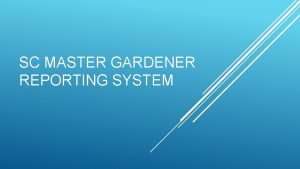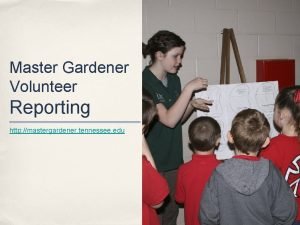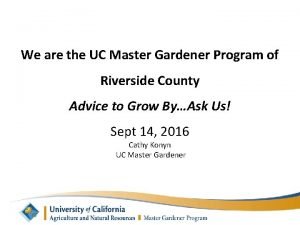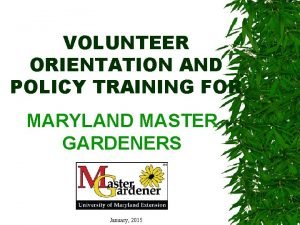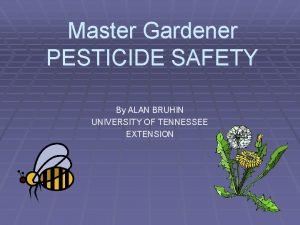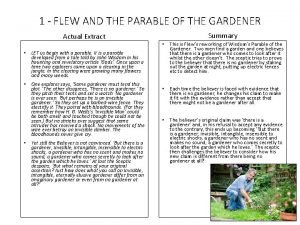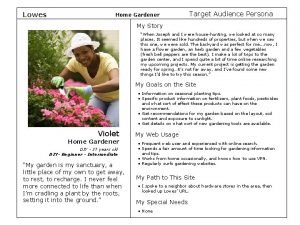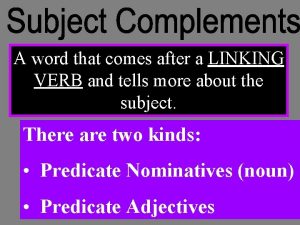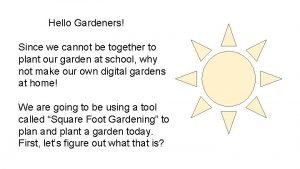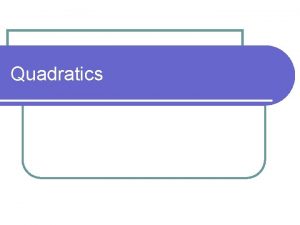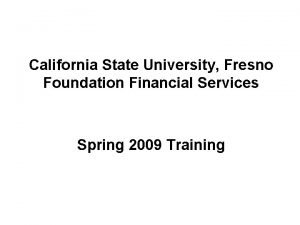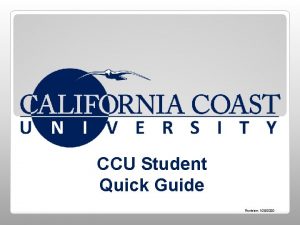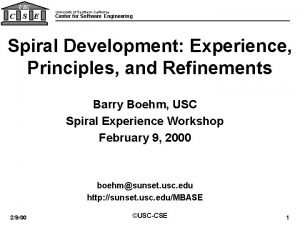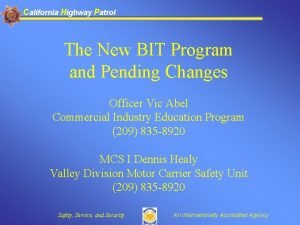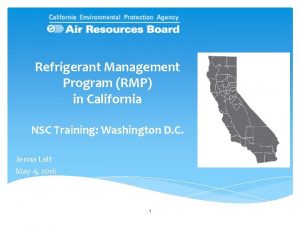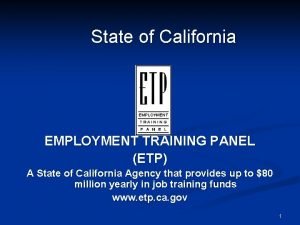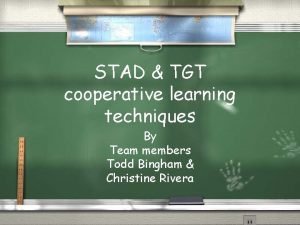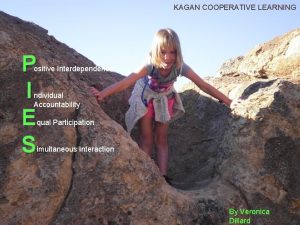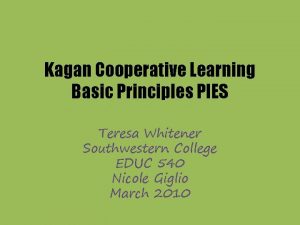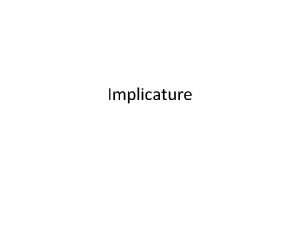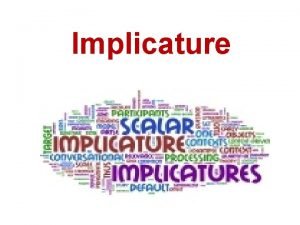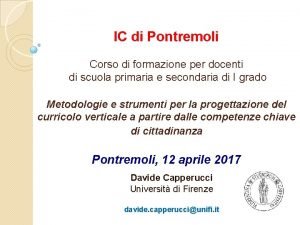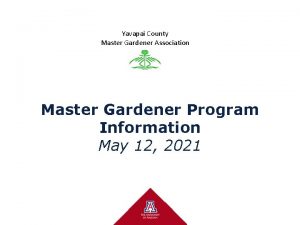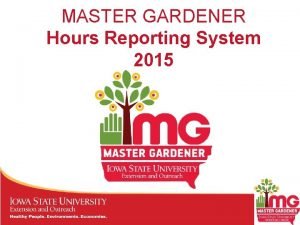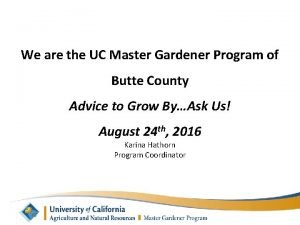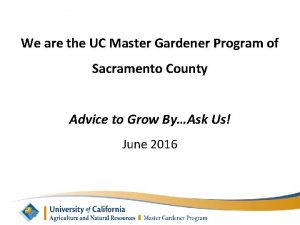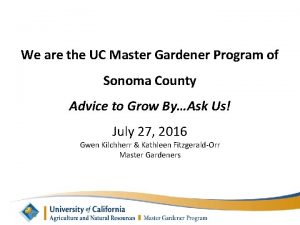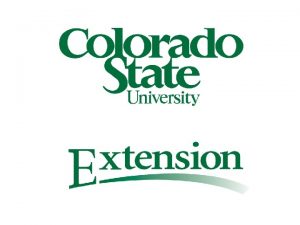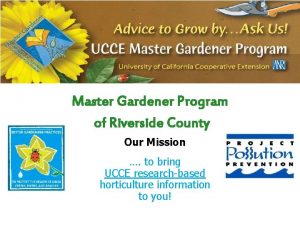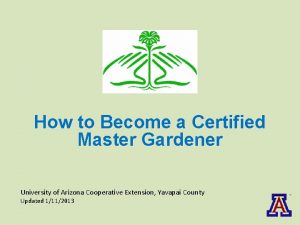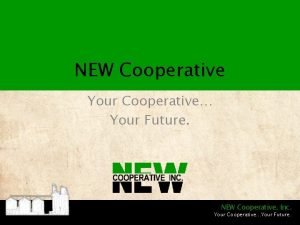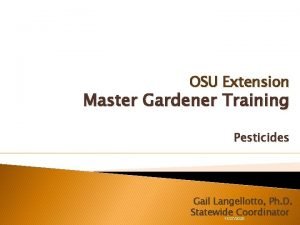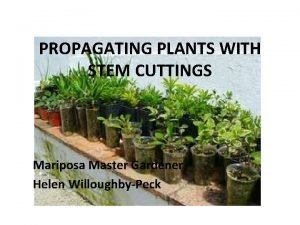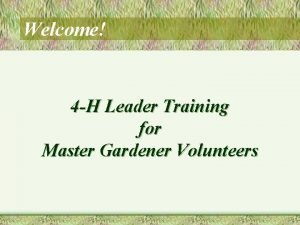UC Master Gardener Program University of California Cooperative


















































- Slides: 50

UC Master Gardener Program University of California Cooperative Extension Napa County Welcome to Spring & Summer Vegetables March 2016

Who Are Master Gardeners? Volunteers providing practical horticultural information to Napa County residents, based on extensive training , and staying updated on UC gardening research. 2

A Brief Advertisement • UC Cooperative Extension Trained Volunteers • Help Desk • Public Workshops • Public Speakers 3

Today’s Agenda • Introductions & Interests • Preparing Your Site • Soil: Amendments & Fertilizers • What to Plant & When 4

And There’s More • Irrigation • Online Resources • Samples of Good & Bad Transplant Material • Demonstrations : Planting Seeds & Transplanting 5

Preparing Your Garden Site 6

1 st Rule of Garden Soil Preparation: DO NO HARM! • Avoid compaction. Never try to work wet soil. • Avoid excessive soil disturbance. Worms and microbes can be destroyed by a rototiller. Can bring up weed seeds. • Avoid overuse of chemical and synthetic fertilizers, herbicides and pesticides, over-fertilizing, over-watering, severe under- watering. Moderation is key. 7

2 nd Rule of Garden Soil Preparation: REMOVE ALL WEEDS! To hoe or not to hoe…. . that is the question! PULL THEM – CUT THEM – ROTOTILL 8

3 rd Rule of Garden Soil Preparation: Know What You’re Doing Before You Do It! Good Soil – Our native soil is often clay-based. Incorporate organic soil amendments to improve poor soil and increase yield. Level Ground – Level ground is easier to prepare, plant and irrigate. Water Supply – Locate your garden near a water supply easily reached with a hose. Adequate Light - Vegetables need at least 6 -8 hours of sunlight each day. Close to Home – Plant your garden near your home, making it easier to work in and carry tools back and forth. 9

Plan ahead • Plant vegetables that your family likes and in quantities that you will use. • Plant only as large a garden as you can maintain easily. • Plant disease-resistant varieties that are adapted to your area. • Think about sharing produce. • Use mulch to help conserve soil moisture, reduce frequency of irrigation, and control weeds. • Check irrigation system periodically for leaks or clogs.

When you plan your garden…. • • Set up your garden in blocks rather than rows Provide windbreaks as needed Keep tall plants from creating unwanted shade Plant some crops now that take advantage of cool weather

• Plants grow well in soil that … Has a healthy physical structure Contains essential micronutrients 12

Some essential garden terms that people sometimes mix up Compost Mulch Amendments Fertilizer

Compost: A mixture of organic matter that is decomposed, i. e. , been digested by organisms • Make it at home • Buy it from recycling plants • Buy it in bags from stores (expensive option) 14

Mulch: Material layered on top of the soil to cover and protect it. Mulch serves many purposes: preserves moisture, reduces weeds, prevents erosion, also can slowly add some micronutrients. Mulch is usually organic (leaves, grass clippings, compost, straw, etc. ) but can be inorganic (e. g. plastic). One of the best mulches is compost

Amendments: Material mixed into the soil to improve the texture or physical condition of the soil to support healthy plant growth (tilth). • Some examples of amendments include: • Barnyard manure • Green Manure and Cover Crops (E. g. Fava Beans, Mustard, Vetches) • Packaged mixes

One of the best amendments is compost • Compost develops into humus to improve soil structure • Improves drainage and aeration • Conserves soil moisture • “Finished” compost can be mixed into the soil right before planting

Distinguish between amendments that can be added right before planting and those that can’t • Some amendments (animal manure, green manure) should be added early enough that organic materials can break down.

Fertilizers: Substances added to soil to provide plants with essential micronutrients Nitrogen–Phosphorous--Potassium X-X-X The three numbers on fertilizer bags and boxes sold in stores show much of the three most essential micronutrients the product will provide

• 5 -X-X Nitrogen (N) promotes green leafy growth • X-5 -X Phosphorus (P) assists in flower, seed, and fruit production • X-X-5 Potassium (K) helps develop root and tubers

Organic Fertilizers • Include variety of nutrients. • Can amend and improve soil. • Encourages micro-organisms in soil • Slow release. • Less likely to “burn” plants

Organic Fertilizer Examples • Commercial organic fertilizers • Animal manures • Seaweed (kelp) • Fish meal or emulsion • Soybean meal • Alfalfa pellets • Bone and blood meal

Synthetic Fertilizers • Fast-acting • Often less expensive • Can be hazardous to plants or soil if used incorrectly or too much • Key: Use according to the direction on the bag/box and in moderation to avoid environmental pollution due to overuse.

Ways to Fertilize • Add to soil before planting (slow release forms are an option) • Foliar feed: spray a mist solution to be absorbed by osmosis. • Liquid solutions: Watering can • “Side-dress” by working a granular fertilizer into top inch of soil near plant roots and water in well.

When Do I Plant? • Cool season vs warm season plants • Our climate considerations for spring and fall • Use a reliable resource

Cool Season Crops • Grow best in day time temperature range of 55 to 75 degrees Fahrenheit • Tolerate some amount of short-term freezing (frost tolerant)

Warm Season Crops • Grow best at 65 to 95 degrees Fahrenheit • Are injured or killed by frost


IRRIGATION, VEGGIES & YOU Water needs depend on many factors Soil Condition (sandy, clay, loam) Weather and wind Ambient temperature Type of vegetable

More Rain Coming? Don’t count on it: Plan your garden and watering methods accordingly

Over Head Sprinklers? Low labor time, BUT need to water a long time to get deep into roots; water loss to evaporation

Hand Water? Labor intensive; Unlikely to get to roots. Need to get down to base of plant. Water evaporation

Here’s the Right Way! Get to the root of the issue

Plan Before Planting • Lay out: Blocks vs. long rows • Group plants by water needs • Install drip systems with built in emitters before planting

DRIP System By Zones MG OK Provides deep watering at roots

When to Water Test: Water if dry at 3 -4 inches Monitor Regularly Avoid over watering. NOTE: Drooping leaves does NOT always mean the need for watering. Check the soil. Avoid overwatering. Roots can drown.

Critical Periods for Adequate Watering: Vegetable Period Pea Flowering & seed enlargement Pepper Flowering through harvest Pumpkin Fruit forms Squash Bud forming & flowering Swiss Chard When true leaves form Tomato Flowering through harvest Lettuce When true leaves form

Critical Periods for Adequate Watering: Vegetable Period Bean Flowering/forming pods Broccoli Forming heads Corn Silking, tasseling, forming ears Cucumber Flowering; fruit forming Eggplant Flowering through harvest Melon Fruit set & early development Onion Bulb enlargement

Master Gardeners Online Search: “Napa Master Gardeners” Or: http: //ucanr. edu/sites/ucmgnapa/ 39

Gardening Resources 40


42

Example 43

44

Garden Questions 45

Workshop Documents Online Click Here 46

Ready to Get Down & Dirty? Demonstrations on how & then it’s your turn (You get to take them home) Planting seeds Transplanting seedlings Demonstrations Only: • Planting seeds in ground (carrots, peas, etc) • Planting tomato seedlings • Using row covers 47

Tips on Buying Seedlings Would you buy any of these examples? Beet Radish Why? Broccoli Cabbage

Burning Questions 49

Thanks! Be sure to complete the evaluations before leaving 50
 Sc master gardener
Sc master gardener Master gardener tennessee
Master gardener tennessee Master gardener
Master gardener Virginia master gardener volunteer management system
Virginia master gardener volunteer management system Master gardener sprayer
Master gardener sprayer Nsa director's summer program
Nsa director's summer program Osha alliance program
Osha alliance program Grant huang va
Grant huang va Parable of gardener
Parable of gardener Gardener persona
Gardener persona Forest personification
Forest personification Is comes a linking verb
Is comes a linking verb Hello i am a gardener
Hello i am a gardener A vegetable gardener has 40 m of fencing
A vegetable gardener has 40 m of fencing Adrian gardener
Adrian gardener California state university long beach nursing
California state university long beach nursing Csu fresno foundation
Csu fresno foundation Uci webreg
Uci webreg California coast university challenge exam answers
California coast university challenge exam answers University of california
University of california Mary marcy dominican university
Mary marcy dominican university California university of pennsylvania global online
California university of pennsylvania global online University of southern california
University of southern california University of southern california
University of southern california Regents of university of california v. bakke
Regents of university of california v. bakke California solar initiative thermal program
California solar initiative thermal program California bit program
California bit program Refrigerant management program
Refrigerant management program California etp program
California etp program Monash university mph
Monash university mph Mkm subu
Mkm subu Prague finance institute
Prague finance institute Osu master cattleman
Osu master cattleman Bluecare saba cloud training
Bluecare saba cloud training Ohio valley educational cooperative
Ohio valley educational cooperative Cooperative model example
Cooperative model example Cooperative vs collaborative learning
Cooperative vs collaborative learning Tgt cooperative learning
Tgt cooperative learning Social definition
Social definition Cooperative governance
Cooperative governance Cooperative learning ideatore
Cooperative learning ideatore What is maxim of quality
What is maxim of quality Cooperative thread array
Cooperative thread array Think pair share cooperative learning
Think pair share cooperative learning Industrial estate examples
Industrial estate examples Pies kagan cooperative learning
Pies kagan cooperative learning Pies principles
Pies principles Cooperative games in physical education
Cooperative games in physical education What is conventional implicature
What is conventional implicature Particularized conversational implicature examples
Particularized conversational implicature examples Compito di realtà esempio
Compito di realtà esempio
